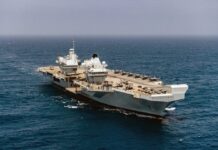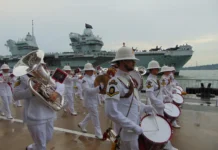
British Naval Gun Mountings. From 1890: 18-inch to 4.5-inch Mark 8. By Ian Buxton. Seaforth Publishing, Barnsley, 2024. ISBN 978-1-3990-5996-1 (hardback) ISBN 978-1-3990-3099-1 (ePub).
Reviewed by David Hobbs
Ian Buxton is a naval architect with a lifetime’s experience in shipbuilding who is now involved with higher education at the University of Newcastle. His previous books, all reviewed for the ANI, include Big Gun Monitors and Diary of a Wartime Naval Constructor.
In the latter he gave insight into the diary of Sir Stanley Goodall, one of the most significant warship designers in the first half of the twentieth century. He has also co-authored The Battleship Builders and Battleship Duke of York with Ian Johnston and written several profusely-illustrated monographs for other publishers on the scrapping of warships at the end of their service lives.
In this book he concentrates on the complex, non-transferable mountings that formed the main armament of battleships, battlecruisers and cruisers. Many of these were masterpieces of engineering and design in their own right and some of them weighed over 1,000 tons. The main armament of a battleship could take two years to build and their procurement amounted to at least a quarter of the ship’s cost. Smaller calibre transferable mountings which were bolted to the deck and could, by definition, be easily transferred between ships are not included. The smaller mountings described in the last chapters such as the 4.7-inch Mark XX and 4.5-inch Marks II, IV, 6 and 8 were fitted to destroyers and frigates.
The book is divided logically into chapters with the first describing how heavy gun mountings worked, how the Admiralty placed contracts for them which were separate from those for the hull and how payments were made as construction progressed. Subsequent chapters describe the biggest gun makers, Armstrong Whitworth and Vickers which amalgamated to form Vickers Armstrong and to a lesser extent the Coventry Ordnance Works. Subsequent chapters deal with specific gun calibres and their mountings beginning with the 12-inch fitted in battleships from 1890. The 215 pages of text are enhanced by 150 excellent black and white photographs, 24 black and white drawings and no less than 70 colour drawings which show the internal workings of mountings in detail. The photographs include images of mountings under construction, completed mountings and their interiors, installation in ships and, interestingly, views of ships being scrapped to show aspects of mountings that would not otherwise have been visible. Appendices list the guns and mountings manufactured at Barrow-in-Furness and Elswick-on-Tyne, the principal UK manufacturing locations.
Whilst the majority of the guns and mountings described armed Royal Navy warships, a number are described that also equipped Royal Australian Navy ships including the battlecruiser Australia. Her twin 12-inch Mark B VIII* mountings, each with two Mark X guns, are described in detail as are the twin 8-inch Mark I mountings with their Mark VIII guns which armed the heavy cruisers Australia II and Canberra. The twin 6-inch Mark XXI mountings with their Mark XXIII guns that armed the cruisers Sydney, Perth and Hobart are also well covered and the author managed to trace the history of each mounting and gun through the RAN’s excellent records. This did not always prove possible with the less complete surviving RN records. The destroyer HMAS Tobruk was the first ship to be fitted with a 4.5-inch Mark 6 mounting, followed by the destroyers Vampire, Vendetta and Voyager and the Type 12 frigates. Some RAN mountings were manufactured at the Government factory at Bendigo, others at Elswick in the UK. The 4.7-inch and 4-inch mountings used by the RAN fell into the transferrable category and were not covered within this book. The author describes the 4.5-inch Mark 8 mounting, widely fitted to RN ships since the 1970s, as the last British-designed gun mounting to date since the 5-inch, 62 calibre gun to be fitted to the Type 26 frigate and already widely used by the RAN is manufactured in Minneapolis, USA, albeit by a British company, BAE Systems.
For those with a more analytical interest in warship design and capabilities, the level of detail in this book, especially the coloured ‘as fitted’ drawings of gun mountings and ammunition handling arrangements, allows fascinating insight into how gun armament worked, what the guns were capable of and how many men it took to keep them in action. A wealth of data is described and illustrated that is unlikely to be readily available to Australian researchers and this adds significantly to other books that focus mainly on ships’ machinery and hull particulars without necessarily covering any aspect of the armament beyond the number and calibre of the guns. It surpasses previous books on this subject, many of which are in any case out of print, and can therefore be considered to fall into the essential category for a wide range of readers. This is especially so in the case of the heavy mountings that form the largest part of the text, illustrations and drawings and, since we are unlikely ever to see their like again, this book may well become the last word on the subject. I thoroughly recommend it.



